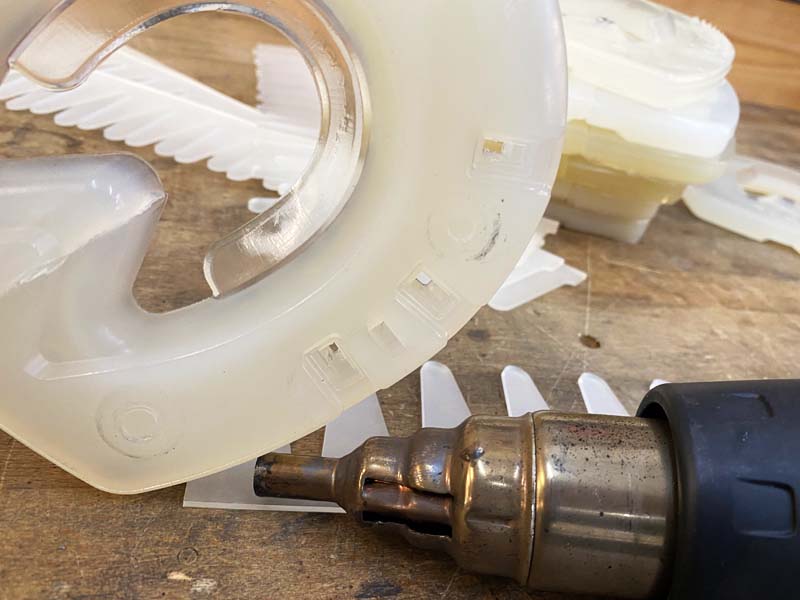Welding Device — Plastic Welding for Glue-on Horseshoes
go to the online shopPlastic Welding Made Easy – Our Welding Device For Stable Welding Seams on Your Glue-On Horseshoes
For a long time, glued horseshoes had the reputation of not working and being quickly lost. Even today, when talking to our customers, we often hear concerns about lost shoes. However, those who, like us, delve into the subject in detail, find that the application of glued horseshoes is now effective and reliable. Furthermore, glue-on horseshoes are increasingly gaining significance in the equine market.
The decision to glue a horseshoe is often made out of necessity. However, more and more horse owners are also choosing glued horseshoes out of conviction, and thus, adhesive shoeing is slowly but surely emerging from its niche. The products for glued hoof protection have now become a significant part of our range. Advancements in adhesive technology have also contributed to an overall improved durability of glued horseshoes. In the past, glued horseshoes were often viewed as a temporary emergency solution. In the past, glued horseshoes were often viewed as a temporary emergency solution. This perspective is now a thing of the past, and many horse owners opt for glue-on shoes.
Overall, it is evident that glue-on horseshoes now present an attractive alternative to traditional shoeing. An increasing number of horse owners recognize the benefits of glued hoof protection and consciously opt for it. Therefore, it is no surprise that glue-on shoes have firmly established themselves in the equestrian world. The market responds to this demand by offering a variety of products and solutions.
Among these solutions is our welding device, specifically designed for plastic welding our products using hot air.
It is important for us to emphasize that gluing horseshoes also requires professional handling. An experienced farrier should master the necessary glue-on techniques to correctly apply the shoes and the horse owner and/or rider must regularly inspect the glued hoof protection, just like any other kind of hoof protection.
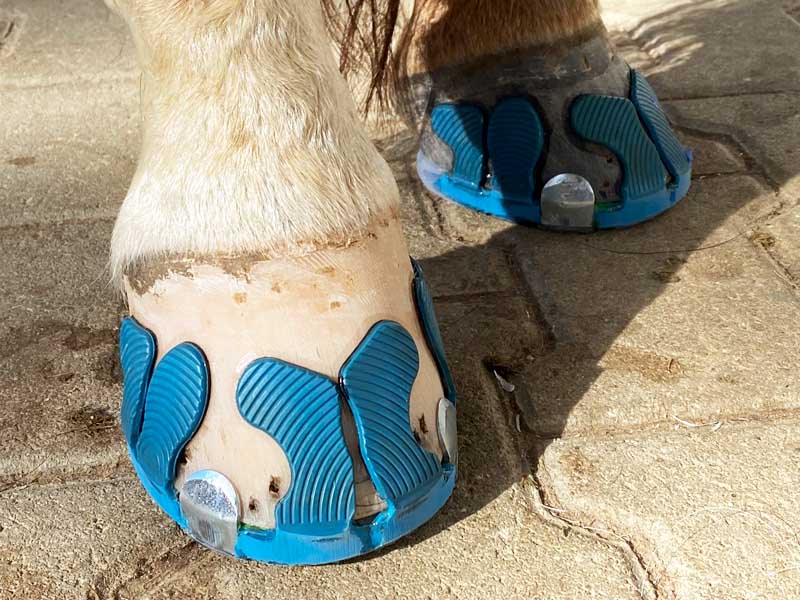
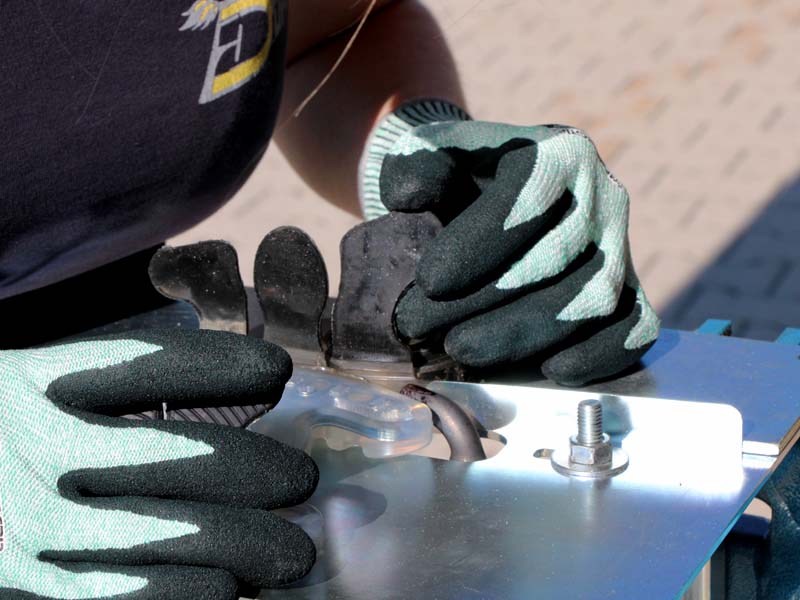
Why should you use the device for your plastic welding tasks?
The stability of your welding seams is a crucial aspect for a successful and durable glue-on shoe.
The stability of the welding seams between the adhesive tab or collar and the used base plate determines the resilience of the glue-on shoe on the hoof. This applies regardless of whether the base plate is a composite shoe or a pure plastic shoe without a metal core.
With some practice, our welding device allows you to achieve uniform and thus stable welding seams, all while saving working time!
Benefits of Using the Welding Device
- Time Saving – plastic welding the glue-on tabs to the horseshoe with the device is quicker than without
- Durability - the material of the welding plate is galvanized and won't corrode
- Flexibility - both your hands are free during the welding process and can take care of important details
- Uniformity - even as an untrained user, our device helps you heating the horseshoe and the glue-on tabs evenly and achieving uniform and thus stable welding seams
- Reliability - the reproducible and uniform welding seams make your glue-on horseshoes more durable and more successful
- Precise Airflow – The hot air flow is precisely directed thanks to the device, preventing, with careful application, for example, the redirection of the hot air flow onto the inner layer in the case of Wolf Busch® tabs.
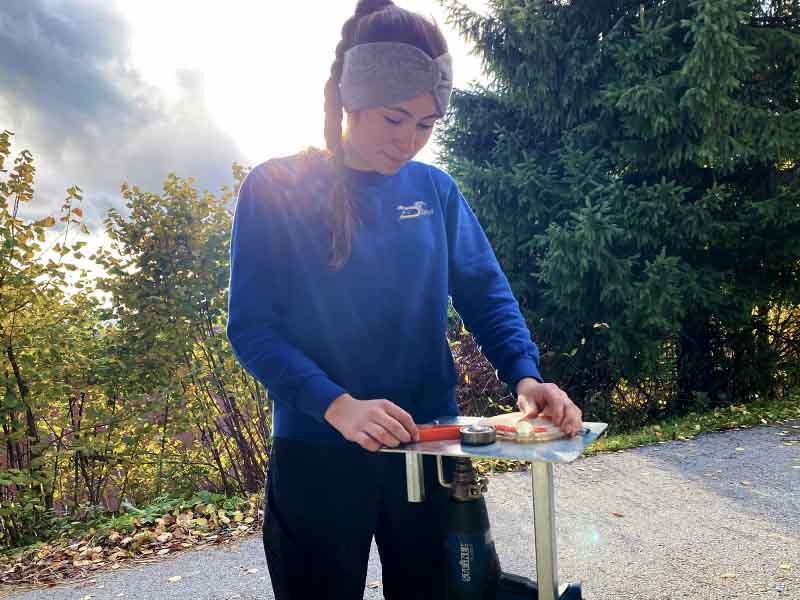
Mini vs. Standard Device
The Standard welding device has another advantage in addition to the above:
It is height-adjustable in combination with a hoof stand (approximately between 90cm and 107cm).
This allows it to be adapted to your body size and your preferred working posture during welding.
The Mini device is aimed at those seeking a more budget-friendly but equally efficient base for uniform welding seams. It provides the same functionality but lacks the convenience of the Standard version, as it cannot be mounted on an anvil or hoof stand without manual adjustment.
Content and Included Accessories of the Two Devices
Both versions come with a special attachment featuring a Steinel reduction nozzle. The modified reduction nozzle is compatible with the hot air guns HL 2020 E and HL 1920 E, as well as HL 2010 E and HL 1910 E from the Steinel brand.
Of course, there are differences in the scope of delivery between the Mini and Standard variants as well.
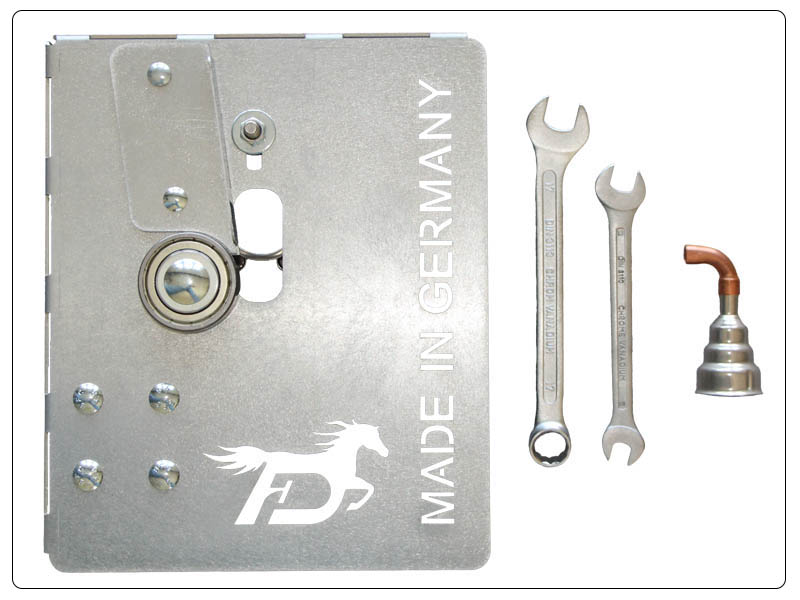
welding board "Mini" ball bearing, and a holder for the hot air gun
reduction nozzle 9mm with special attachment
distance pieces (2x 2mm) and one tinkering piece
combination spanner wrench 17mm
open-end wrench 10/13mm
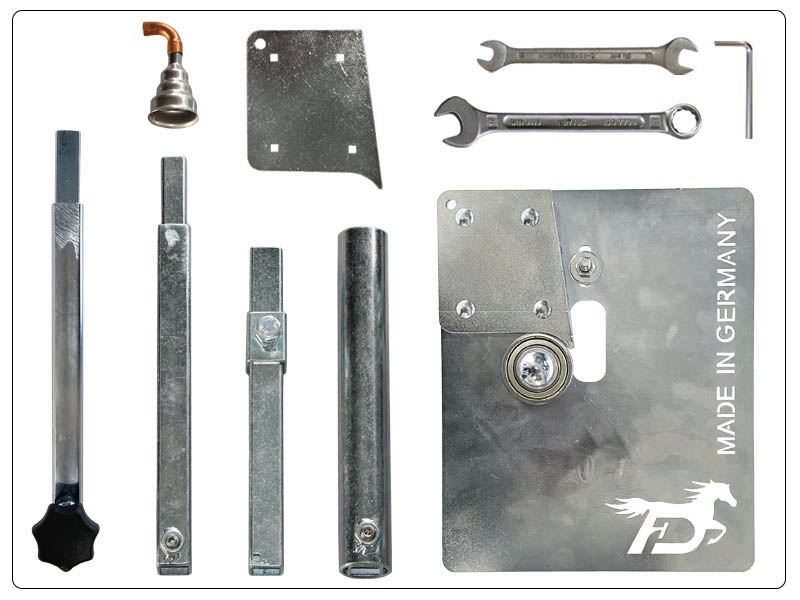
welding board "Standard" ball bearing, two integrated square tubes, and a holder for the hot air
gun
reduction nozzle 9mm with special attachment
distance pieces (2x 1mm, 1x 2mm, 1x 4mm)
combination spanner wrench 17mm
open-end spanner wrench 10/13mm
hex key
attachment square pipe with screw handle and one extension (270mm)
attachment square pipe for anvil (height-adjustable)
attachment pipe for hoof stand
Plastic Welding with the Welding Device
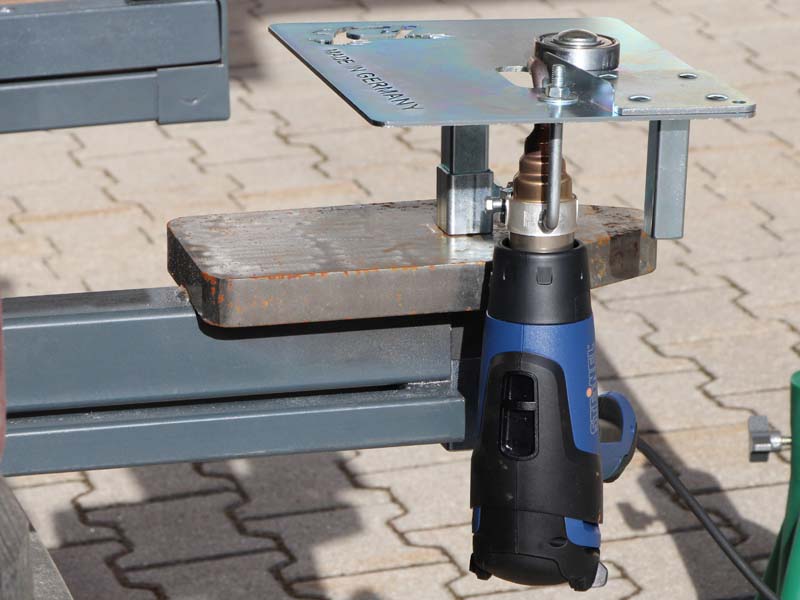
The standard welding device on the anvil.

The standard welding device in the vise.
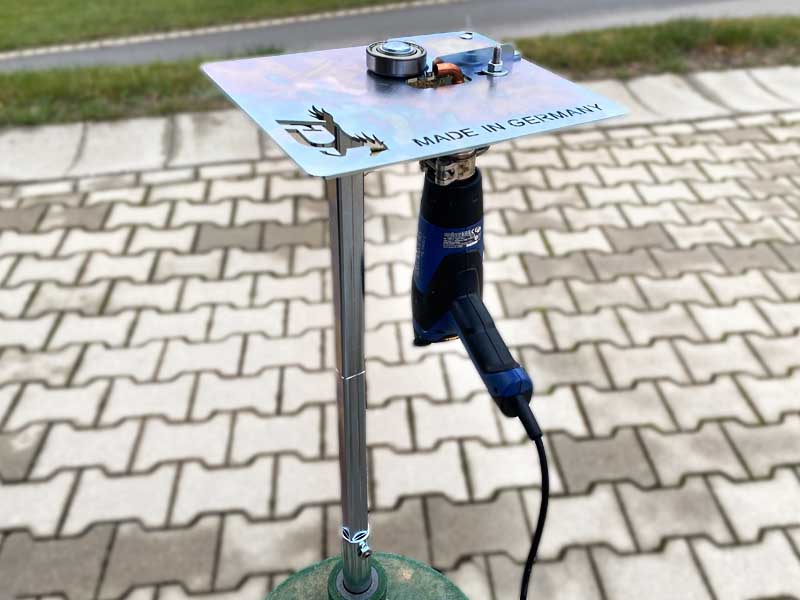
The standard welding device on the hoof stand.
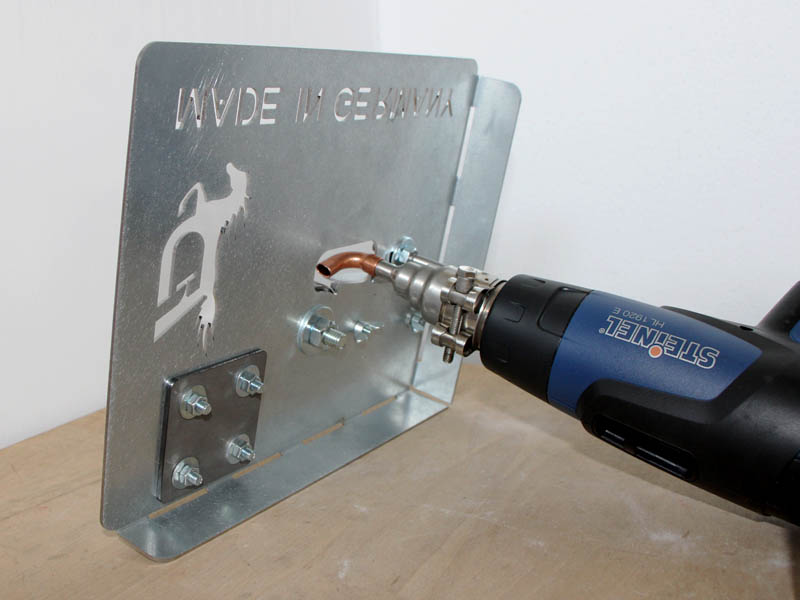
The Mini welding device cannot be mounted on the anvil or hoof stand without manual adjustment.
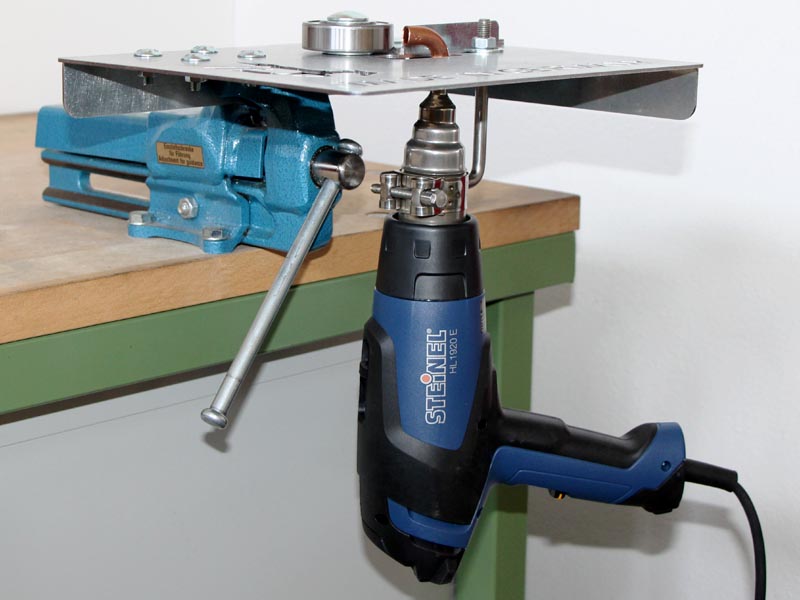
The Mini welding device, just like the standard version, can be easily attached to a vise.
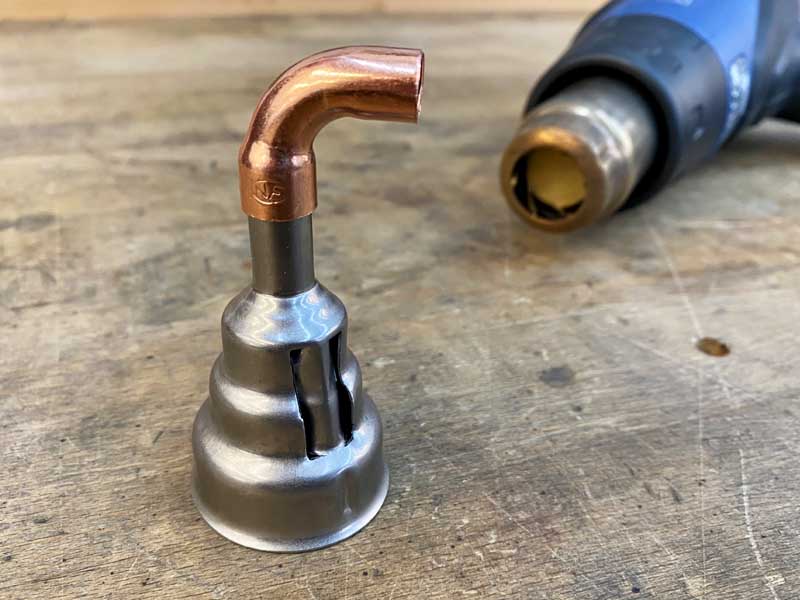
Both plastic welding devices come with a Steinel reduction nozzle and the required special attachment.
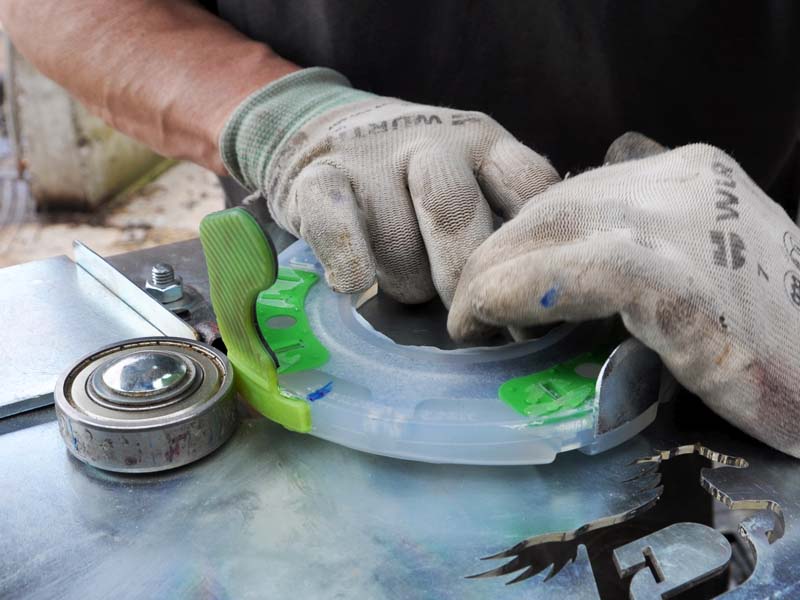
In case of a clipped horseshoe, the glue-on tabs are split and welded in front and behind the quarter clips.
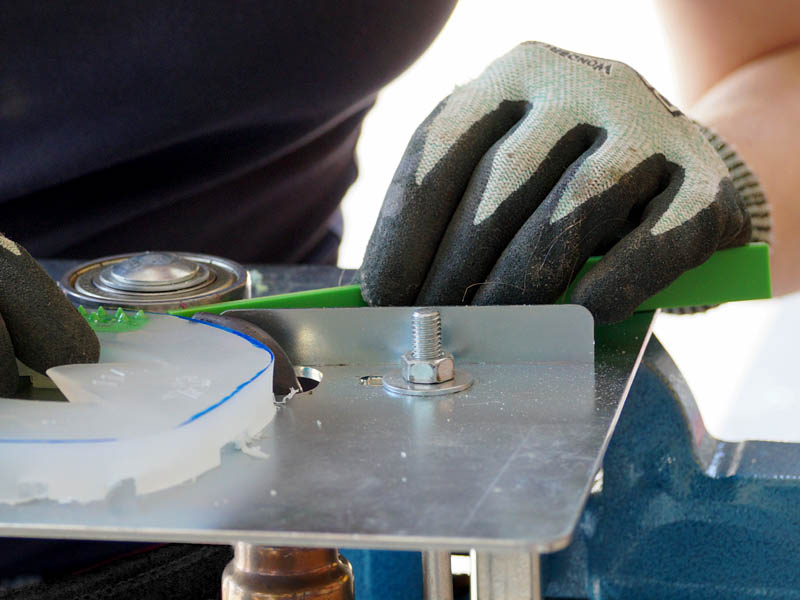
Die Schweiß-Vorrichtung ist auch zum „Heißluftkleben“ der Farbstreifen an den Beschlag geeignet.
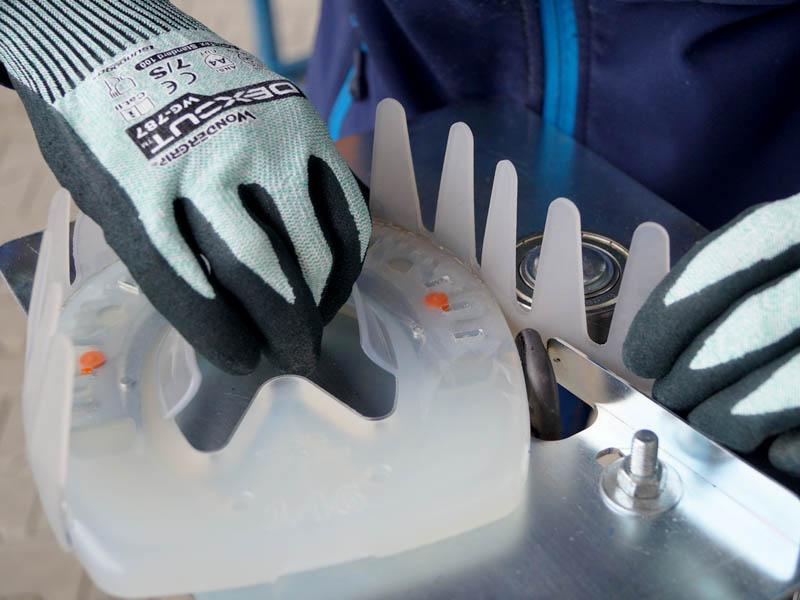
Certainly, our adhesive collars Pro and Easy can be plastic-welded onto a composite or pure urethane horseshoe using our welding device.
Application and Safety Instructions for Plastic Welding - Video
Please note our safety information or assembling and using the welding device, as well as the manufacturer's safety guidelines for your hot-air gun. Ensure you take all necessary safety precautions for welding. These include wearing personal protective equipment, maintaining an organized workspace, and ensuring proper ventilation when welding with plastics. Ideally, perform the work outdoors. If you use our products in combination with the device, make sure to follow the currently applicable safety instructions for our products and the corresponding accessories.
Assembly Instructions
Setting up the welding device doesn't take long.
All information can be found in the respective assembly manual. A German instruction manual is included in the delivery, and the corresponding versions in your languages are linked for download.
The Purpose of the Spacer Plates
When gluing, it is important that the adhesive collar or the adhesive tab does not protrude into the profile of the horseshoe or extend beyond the bottom edge of the horseshoe.
Here, the distance piece comes into play; in combination with our welding device, it ensures that the correct distance between the adhesive tab and the horseshoe is maintained during the welding process.
Plasic Welding Procedure with the Welding Device
Before you start the welding process, please remember to optimize the horseshoe to fit the horse's hoof and to sand down any existing knobs. We would like to point out that it may also be necessary to adjust the adhesive tabs to the hoof. For further details, please refer to the respective product descriptions.
Please observe the following instructions when welding with our device. These instructions apply to both devices equally:

- Use the appropriate distance piece. Depending on the shoe or adhesive collar/tabs, you will need a different distance piece. Ensure that the lowest point of the circular curvature between the tabs is flush with the upper edge of the horseshoe.
- For the color strips, you do not need a distance piece.
- Clamp the adhesive collar into the designated track between the roller and the welding plate.
- Roll the horseshoe slowly and evenly.
- Mark the starting point and endpoint of the weld intentionally by applying slightly more pressure.
- Along the entire length, a glassy bead should be visible at the welded edges.
- After completing the welding, check the fit on the hoof and round off the welded edges slightly towards the bottom side.
Further tips for a successful adhesive shoe can be found in our video, in the adhesive instructions on our website (FAQ → Instructions), and of course, in the product descriptions of the adhesive collars or tabs.
Tips and Tricks for Successful Plastic Welding for Effective Hoof Protection:
Here's a tip for everyone starting to glue: Take a look at our starter sets. Your purchase becomes doubly beneficial thanks to the set items: not only do you save time with a quick purchase, but you can also benefit from the additional price advantages of the set items. The M-set includes the Mini device, and the L-set includes the Standard welding device.
Tear Test - Check the Stability of the Welded Seams of the Adhesive Shoe
The welded seam of the adhesive shoe will be subjected to immense forces on the hoof. Therefore, we always recommend conducting a tear test once the welded seam has cooled down.cv
If the plastic welding fails during this manual check, the adhesive shoe would likely not hold well on the hoof for long. Do not hesitate to pull with full force because the forces later acting on the welded seam on the horse's hoof are much greater.

The Correct Speed for the Welding Work
Whether you rotate the horseshoe horizontally using the welding device or roll it vertically on another surface to weld it to the adhesive collar, it is important to execute the movement slowly but at a consistent speed to achieve a uniform welded seam.
Here, one of the greatest advantages of plastic welding with our welding device becomes apparent again because you have both hands free to focus on the plastic parts, as the hot air gun is fixed in the device. When welding on another surface, you may need to hold the hot air gun in your hand, which can also lead to the hot air flow not being precisely centered between the tab and the horseshoe.
For successful welding of alternative adhesive shoes, not only a steady hand but also knowledge about the plastic used for the shoe or the adhesive tabs is crucial.
Even though, in principle, all our Wolf Busch® tabs (regular, soft, Edition) and our collars Pro (Standard and Extra) and Easy can be welded with (almost) all horseshoes from our range, depending on which plastic material (Standard, Extra, Regranulate, with or without color) are being welded together, you may need to adjust the rolling speed and the temperature of the hot air gun accordingly.
Plastic Welding Tab and Horseshoe with the Device
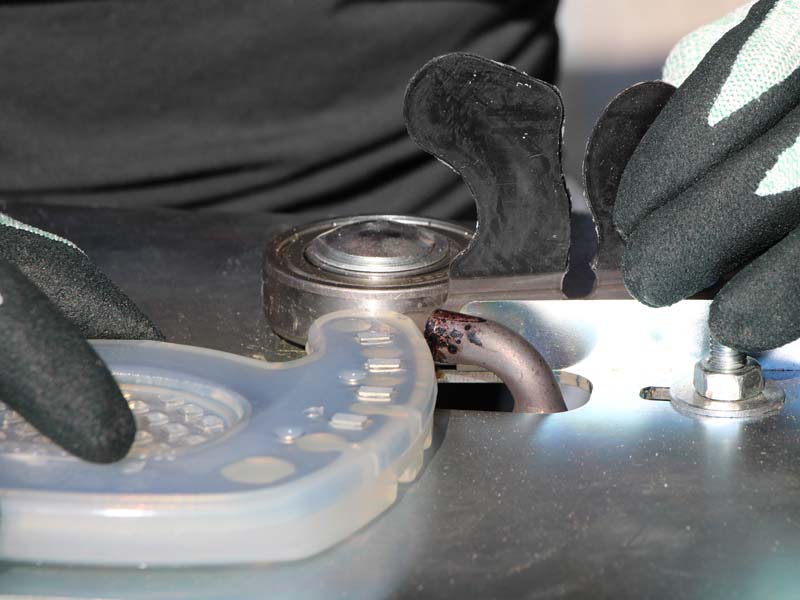
The adhesive collar is securely fixed, the airflow is properly directed, and you have both hands available for the welding work.
Plastic Welding Tab and Horseshoe without the Device
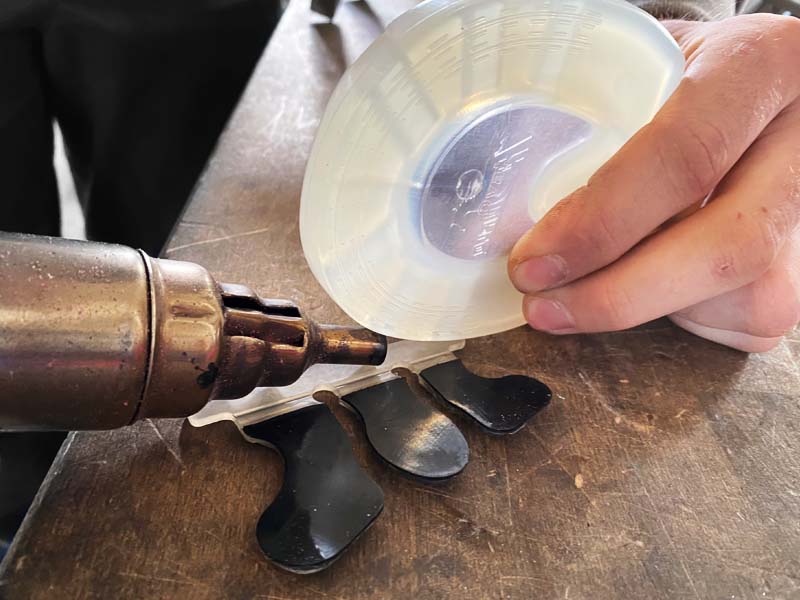
Ensure that the adhesive collar is securely fixed to prevent slipping and make sure that the airflow is properly directed.
Choosing the Right Hot Air Gun for Your Welding Needs
The welding fixture comes with a 9mm Steinel reduction nozzle, equipped with a small special attachment. This special attachment ensures that the airflow is precisely directed to the components being welded. We recommend using the Steinel HL 1920 E for welding tasks, as we have personally had the best experiences with this device.
The reduction nozzle that is inclued in the delivery of the welding device is suitable for the Steinel brand hot air guns HL 2020 E and HL 1920 E, as well as HL 2010 E and HL 1910 E.
Gathering Practical Experience in Plastic Welding for Glue-on Horseshoes
As in all aspects of life, the saying "practice makes perfect" holds true here as well.
Even in adhesive horseshoes, lost shoes can become a safety risk, especially in case of clipped horseshoes. However, even if that's not the case, lost shoes are always inconvenient, both for the hoof care professional and the horse owner.
To make "practice" less costly, we offer a Practice Kit consisting of base plate dummies and adhesive collars. By the way, the Practice Kit is also included in the starter set size L, alongside the Standard device.
At this point, we would like to briefly mention our Adhesive Courses (held in German), where you have the opportunity to try out the welding device. All information about available courses can be found in the 'Further Education and Courses' section. The courses are conducted in German. If you are interested in a course in English, please contact our team. If there is sufficient demand, we may be able to organize something
